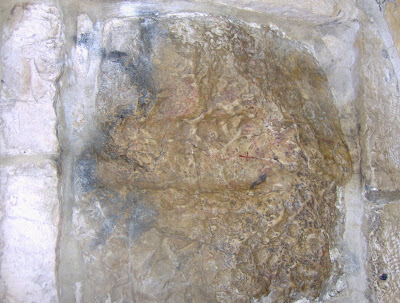Pilgrimage Part Three: Shrines
Almost any site of religious significance in the Holy Land is covered by a shrine--which is sort of depressing if you're looking for a view of Calvary or some other locale as it might have appeared 2000 years ago. Not so inspiring or faith promoting (for me) to visit the Church of the Holy Sepulchre or similar sites, but they are fascinating as human artifacts. Here are some of the sights:
As you walk the via dolorosa, following Christ's path from Gethsemane to Gologtha, there are 14 stations of the cross--places where significant events such as the interrogation of Jesus, his presentation to Pilate, etc. took place. One of my favorites is a spot where Christ is said to have staggered under the weight of the cross and reached out his left hand to steady himself on the wall. His touch--or at least the combined touches of everyone who followed--has left an imprint in the wall:

Once you get into the church that covers the ground where Christ is supposed to have been crucified and buried, you can see that the space is rather jealously guarded by at least 10 different sects--the Ethiopian church, the Armenian church, the Greek Orthodox, the Russian Orthodox, the Roman Catholic... everyone owns a portion of the building. The first sight you see, as you enter the door is a slab of stone said to be the one on which Christ's body laid in the tomb. It was surrounded by worshipers on their knees who kissed it, rubbed clothing/items of personal significance on it, and pressed their foreheads to it. Above the stone itself are lamps and incense--ubiquitous decorations in these shrines.

Our tour guide was good, by which I mean primarily that he had access to many parts of the church--he led us down to an archaeological excavation beneath the church itself which demonstrated that the Church of the Holy Sepulchre was not merely a spot designated by Maria (Constantine's mom) as the site of the crucifixion; in that space, there was a second century (100-199 AD) painting of a pilgrim boat with words that say something like "We have arrived at the place of His death." So at the very least, the church is built on a site that second century Christians believed to be authentic. Here's a picture of the boat:

The other major shrine we visited was the church in Bethlehem supposedly built over the cave in which Christ was born. Whereas I have some degree of confidence that the Church of the Holy Sepulchre is built on the spot where Jesus Christ died and was buried, I have little to no confidence that this church is anything special--there are literally hundreds of caves all around Bethlehem, and Christ could have been born in almost any of them. In any case, if you go to the church, you'll find a marble shrine undergound; inside the shrine is a hollow with liquid in it that worshipers would take and press to their lips, foreheads, etc. I can't tell you what the liquid is--I didn't partake.

Some of the artwork in the Bethelehem church (love that manly baby!):


As you walk the via dolorosa, following Christ's path from Gethsemane to Gologtha, there are 14 stations of the cross--places where significant events such as the interrogation of Jesus, his presentation to Pilate, etc. took place. One of my favorites is a spot where Christ is said to have staggered under the weight of the cross and reached out his left hand to steady himself on the wall. His touch--or at least the combined touches of everyone who followed--has left an imprint in the wall:

Once you get into the church that covers the ground where Christ is supposed to have been crucified and buried, you can see that the space is rather jealously guarded by at least 10 different sects--the Ethiopian church, the Armenian church, the Greek Orthodox, the Russian Orthodox, the Roman Catholic... everyone owns a portion of the building. The first sight you see, as you enter the door is a slab of stone said to be the one on which Christ's body laid in the tomb. It was surrounded by worshipers on their knees who kissed it, rubbed clothing/items of personal significance on it, and pressed their foreheads to it. Above the stone itself are lamps and incense--ubiquitous decorations in these shrines.

Our tour guide was good, by which I mean primarily that he had access to many parts of the church--he led us down to an archaeological excavation beneath the church itself which demonstrated that the Church of the Holy Sepulchre was not merely a spot designated by Maria (Constantine's mom) as the site of the crucifixion; in that space, there was a second century (100-199 AD) painting of a pilgrim boat with words that say something like "We have arrived at the place of His death." So at the very least, the church is built on a site that second century Christians believed to be authentic. Here's a picture of the boat:

The other major shrine we visited was the church in Bethlehem supposedly built over the cave in which Christ was born. Whereas I have some degree of confidence that the Church of the Holy Sepulchre is built on the spot where Jesus Christ died and was buried, I have little to no confidence that this church is anything special--there are literally hundreds of caves all around Bethlehem, and Christ could have been born in almost any of them. In any case, if you go to the church, you'll find a marble shrine undergound; inside the shrine is a hollow with liquid in it that worshipers would take and press to their lips, foreheads, etc. I can't tell you what the liquid is--I didn't partake.

Some of the artwork in the Bethelehem church (love that manly baby!):



Comments